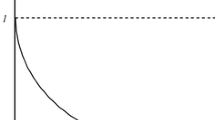Abstract
The e-government movement advocates increased use of technology to improve government efficiency and reduce corruption by reducing the discretionary power of government officials. This paper studies the relationship between improvements in inspection technology within a Principal-Supervisor-Agent model, where the supervisor is an inspector who is hired by the principal to investigate the agent’s potentially illegal actions. We show that when technology increases the marginal or total productivity of the supervisor’s effort, improvements in inspection technology encourage some types of bribery. Although such technological improvements induce an equilibrium with bribery, compliance and social welfare can still rise. However, when technology and supervisory effort are sufficiently substitutable, improvements in technology may reduce compliance when bribery occurs in equilibrium even when those same technological improvements would have raised compliance in the absence of bribery. We also characterize the relationship between the principal’s socially optimal technology and the anti-corruption policy available to the principal and find that the socially optimal inspection technology may be a substitute for or a complement to the anti-corruption policy. Finally, we show that for any set of policies that optimally induces a no-bribe equilibrium, there exists another set of policies that induces an equilibrium with bribery that is pareto superior to it.
Similar content being viewed by others
References
Bac M (1996) Corruption and supervision costs in hierarchies. J Comp Econ 22: 99–118
Bac M (1998) The scope, timing, and type of corruption. Int Rev Law Econ 18: 101–120
Bag PK (1997) Controlling corruption in hierarchies. J Comp Econ 25: 332–334
Baliga S (1999) Monitoring and collusion with ‘soft’ information. J Law Econ Organ 15: 434–440
Besley T, McLaren J (1993) Taxes and bribery. Econ J 103: 119–141
Burlando A, Motta A (2008) Ex-ante and ex-post corruption. Working paper. Available at http://www.decon.unipd.it/personale/curri/motta/index.html
De R (2006) Evaluation of e-government systems: project assessment versus development assessment. In: Proceedings of the electronic government 5th international conference, EGOV 2006, Lecture notes in computer science 4084. Springer-Verlag (Berlin), Krakow, Poland, pp 317–328
Heeks R (1998) Information technology and public sector corruption. Institute for Development Policy and Management. Working paper. Available at http://www.sed.manchester.ac.uk/idpm/research/publications/wp/igoverment
Kim S, Kim HJ, Lee H et al (2009) An institutional analysis of an e-government system for anti-corruption: the case of OPEN. Gov Inf Q 26: 42–50
Mishra A (2006) Corruption, hierarchies and bureaucratic structure. In: Rose-Ackerman Edited International Handbook on the Economics of Corruption. Edward Elgar, pp 189–216
Mookherjee D, Png IPL (1995) Corruptible law enforcers: how should they be compensated? Econ J 105: 145–159
Polinsky AM, Shavell S (2001) Corruption and optimal law enforcement. J Public Econ 81: 1–24
Salanie B (1997) The economics of contracts: a primer. MIT Press, Cambridge
Samuel A (2005) Three essays on the economics of corruption. Ph.D. Thesis, Boston College, Boston
Samuel A (2009) Preemptive collusion among corruptible law enforcers. J Econ Behav Organ 71: 441–450
Tirole J (1986) Hierarchies and bureaucracies: on the role of collusion in organizations. J Law Econ Organ 2: 181–217
Wescott CG (2003) E-government to combat corruption in the Asia Pacific Region. In: Prepared for the 11th international anti-corruption conference. Seoul, Republic of Korea
Yang D (2008) Can enforcement backfire? Crime displacement in the context of customs reform in the philippines. Rev Econ Stat 90: 1–14
Author information
Authors and Affiliations
Corresponding author
Additional information
The authors would like to thank seminar participants at the Midwest Economic meetings (2009), Richard Arnott, and two anonymous referees for their insightful comments.
Rights and permissions
About this article
Cite this article
Samuel, A., Lowen, A. Bribery and inspection technology. Econ Gov 11, 333–350 (2010). https://doi.org/10.1007/s10101-010-0080-0
Received:
Accepted:
Published:
Issue Date:
DOI: https://doi.org/10.1007/s10101-010-0080-0



